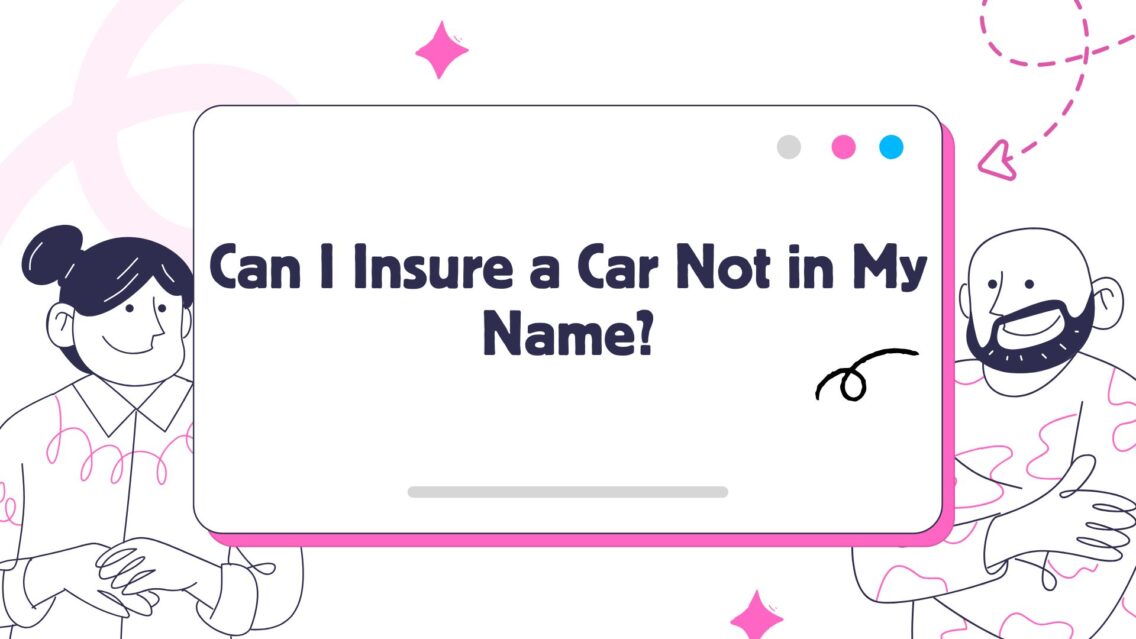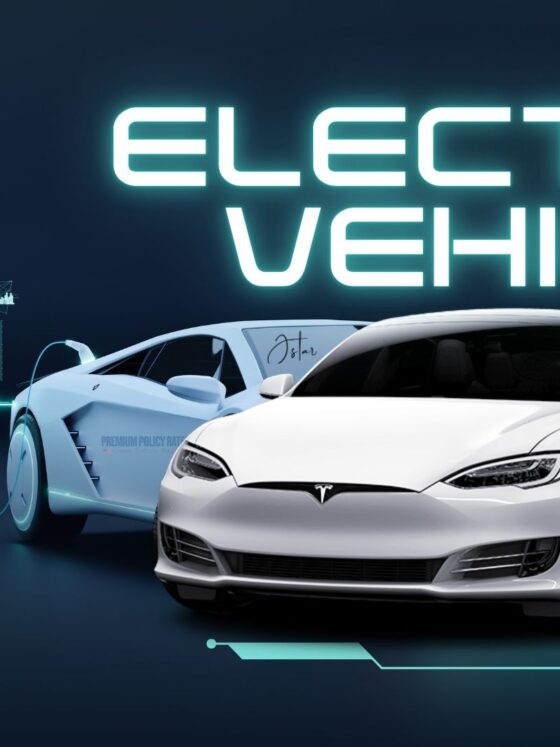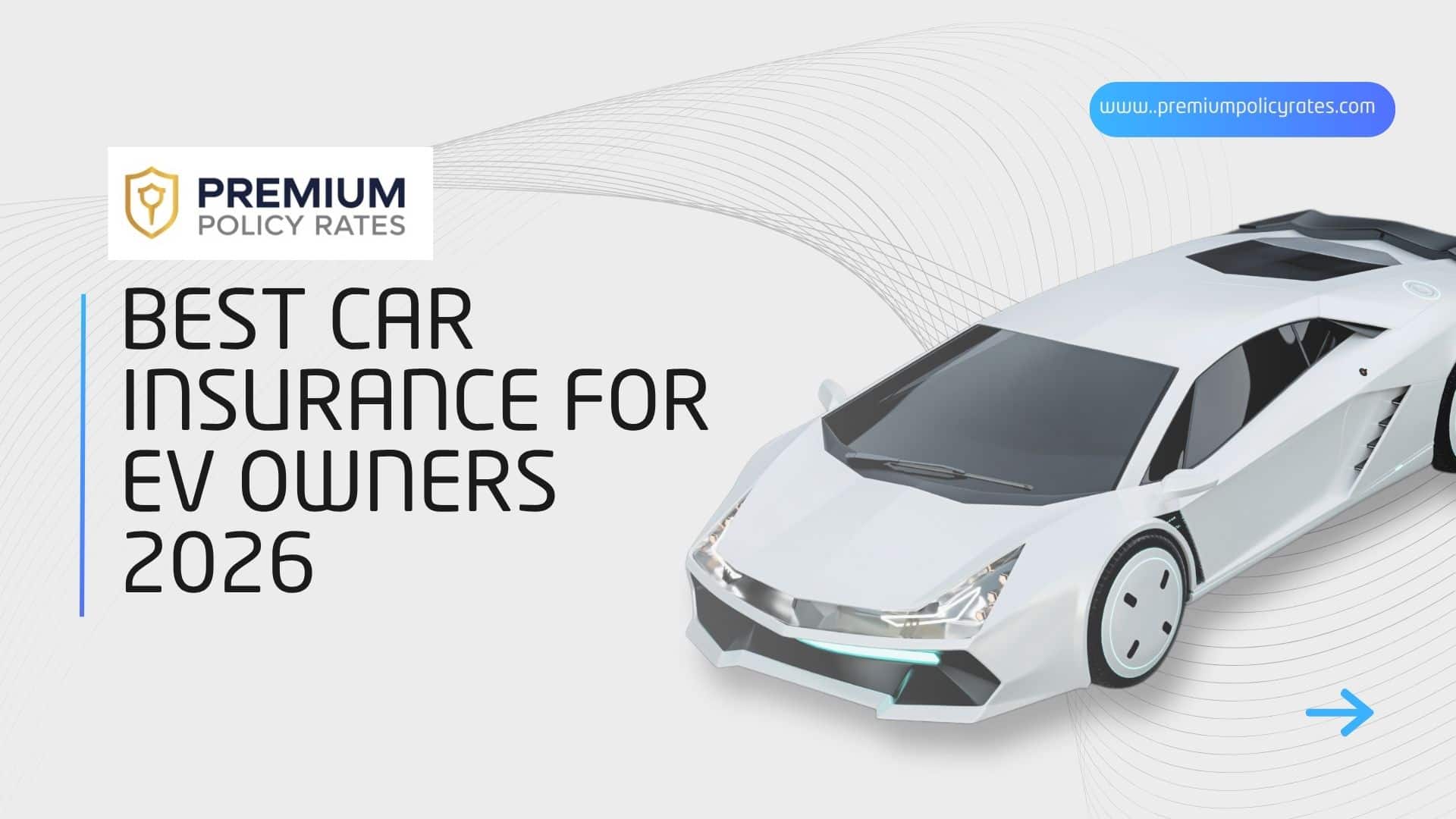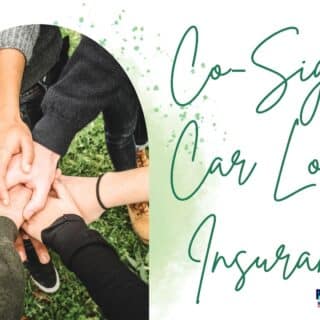Can I Insure a Car Not in My Name? The Ultimate 2026 Legal Guide


If you’ve asked “Can I insure a car not in my name?” you’re not alone. This is one of the most common insurance questions, and the answer involves understanding a critical insurance concept: insurable interest.
Here’s the reality: Car insurance isn’t just about protecting the vehicle—it’s about protecting YOU from financial loss. If a car is destroyed or damaged, you should be the one paying for repairs or replacement. If you have no financial stake in the vehicle, insurance companies have no reason to cover it.
But life is complicated. You might drive your spouse’s car daily. You might co-sign your child’s vehicle. You might lease a car that technically belongs to the leasing company. In these situations, getting proper coverage can be confusing.
This guide answers:
1. What Is Insurable Interest? Why Insurance Companies Care
Before we answer “Can I insure a car not in my name?” you need to understand insurable interest.
1.1 Definition: Insurable Interest
Insurable interest means you would suffer a direct financial loss if the insured item (in this case, a car) were damaged, destroyed, or lost.
Examples of having insurable interest in a vehicle:
| Situation | Why You Have Insurable Interest |
|---|---|
| You own the car outright | If it’s damaged, YOU lose money |
| You financed the car | If it’s damaged, YOU lose money and still owe the bank |
| You lease the car | If it’s damaged, YOU’RE responsible for damages to leasing company |
| You co-signed the loan | If owner can’t pay, YOU’RE responsible for the debt |
| You’re the primary driver | If it’s totaled, YOU lose access to necessary transportation |
| You maintain and register it | You have legal and financial responsibility |
Examples of NOT having insurable interest:
| Situation | Why You DON’T Have Insurable Interest |
|---|---|
| Occasionally borrow a friend’s car | Not your financial loss; no legal responsibility |
| Test drive a vehicle | You have no ownership stake |
| Rent a car | Rental company bears the loss, not you |
| Drive spouse’s car once per month | Primary driver is owner, not you |
| Your neighbor asks to borrow your friend’s car | You have no connection to vehicle at all |
1.2 Why Insurance Companies Enforce Insurable Interest
Insurance companies enforce insurable interest for three reasons:
Reason 1: Prevent Fraud
Without insurable interest requirements, someone could:
- Insure a car they don’t own
- Then deliberately damage it
- File a claim for thousands in damages
- Pocket the insurance money
Real-world example: A person buys an inexpensive used car for $5,000. They insure it for $15,000. They “accidentally” drive it off a cliff. They claim $15,000. This is fraud, and it costs insurance companies billions annually.
Reason 2: Ensure Accurate Risk Assessment
Insurance companies calculate rates based on risk. The “risk” is different depending on your relationship to the vehicle:
- If you OWN the car → You’ll drive carefully (protect your investment)
- If you OCCASIONALLY BORROW a car → You might drive recklessly (not your problem)
Without insurable interest, insurers can’t assess who’s actually taking the risk.
Reason 3: Eliminate Unnecessary Coverage
If you only drive a borrowed car once per month, you don’t need your own policy. You’re already covered under the owner’s “permissive use” clause. Forcing you to get separate coverage would be wasteful.
1.3 How Insurers Verify Insurable Interest
Insurance companies verify insurable interest by checking:
- Title and registration: Does your name appear on official documents?
- Loan/lease documents: Are you financially responsible for the vehicle?
- Address verification: Do you live where the car is registered?
- Driving history: Are you the primary driver?
- Application accuracy: Did you provide truthful information?
- Claim investigation: After an accident, they verify all above
If insurable interest is missing, the insurance company can:
- Deny your claim
- Cancel your policy
- Investigate for fraud
- Report you to state insurance regulators
2. When CAN You Insure a Car Not Legally in Your Name?
Despite the insurable interest requirement, there ARE situations where you can get your own insurance policy on a car that’s not in your name.
2.1 Scenario 1: You’re Financing the Car (Even if Title is Not Yet in Your Name)
The situation:
You co-signed a car loan or are the primary borrower. The car is in someone else’s name (spouse, parent, co-signer) but YOU’RE paying for it.
Why you can insure it:
You have clear insurable interest because you’re financially responsible for the vehicle.
What to do:
- Apply for insurance in YOUR name
- Provide a copy of the loan/finance agreement showing you’re responsible
- List the actual owner as the “lienholder” on the policy
- You become the policyholder; you can make coverage decisions
Timeline: Usually approved within 24 hours
Important note: Many lenders REQUIRE you to get insurance within 30 days of financing. Don’t delay.
2.2 Scenario 2: You’re Leasing the Vehicle
The situation:
You lease a car. The leasing company owns it and holds the title. You drive and maintain it.
Why you can insure it:
Your lease agreement makes you financially responsible for damage. You have insurable interest.
What to do:
- Apply for insurance in YOUR name
- Make the leasing company the “lienholder”
- Provide lease agreement to insurance company
- Coverage required by lease agreement is typically: Collision, comprehensive, liability
Important note: Leases REQUIRE you to maintain specific insurance levels. Skipping coverage violates the lease and could result in:
- Lease termination
- Forced buy-out of vehicle
- Legal action from leasing company
- Major credit damage
Timeline: Usually approved within 24 hours
Typical coverage requirements:
- Liability: Usually 100/300/100 minimum
- Collision: $500-$1,000 deductible
- Comprehensive: $250-$500 deductible
2.3 Scenario 3: You’re the Primary Driver of a Household Vehicle
The situation:
You live with family (spouse, parent, adult child) and you’re the primary driver of their car. You drive it daily. The car is registered and titled to them.
Why you might be able to insure it:
Some insurance companies will allow this if you can prove:
- You live at the same address as the registered owner
- You’re the primary driver (drive it most of the time)
- You’re a household member (spouse, adult child, parent)
- The owner consents
What to do:
- Contact insurance company directly
- Explain your situation (primary driver, household member)
- Provide proof: Lease/mortgage at same address, driver’s license
- Get written consent from owner
- Clarify: Will you be named as policyholder or added as insured driver?
Important note: This is case-by-case. Some insurers allow it; others don’t. ALWAYS ASK before assuming.
Better option: Ask to be added as a driver on the owner’s existing policy (usually easier, same-day approval).
Timeline: 1-3 business days (requires owner consent)
2.4 Scenario 4: You Have a Contractual Obligation
The situation:
You’re legally responsible for the vehicle through a written agreement. Examples:
- Court-ordered child support requiring you to provide car for child
- Business partnership requiring you to maintain vehicle
- Parental agreement making you responsible for teen’s car
- Elderly parent arrangement making you responsible for parent’s car
Why you can insure it:
Contractual obligation creates insurable interest.
What to do:
- Provide written contract to insurance company
- Explain your legal responsibility
- Name yourself as policyholder
- Provide proof of agreement
Timeline: 1-3 business days
3. When CAN’T You Insure a Car Not in Your Name?
These situations make it IMPOSSIBLE to get insurance on someone else’s car:
3.1 Scenario 1: You Only Occasionally Borrow the Vehicle
The situation:
A friend or family member lets you borrow their car once in a while. You’re not a regular driver.
Why you CAN’T insure it:
You have no insurable interest. No financial stake. No contractual responsibility.
What you SHOULD do:
You’re already covered! The owner’s policy includes a “permissive use clause” that covers you when the owner gives you permission to drive.
What NOT to do:
Don’t try to get your own policy. Insurance companies will:
- Deny the application
- Or approve it fraudulently (and later deny claims)
Better option: Just get permission and drive. The owner’s insurance covers you.
Timeline: No action needed
3.2 Scenario 2: You’re Not Financially Responsible
The situation:
You’re not the owner, don’t finance it, don’t lease it, and aren’t contractually responsible. You just drive it sometimes.
Why you CAN’T insure it:
Zero insurable interest. Insurance companies have no reason to cover you.
Example scenario:
Your coworker drives a company car. They let you borrow it to drive a client to a meeting. You can’t get your own insurance on this vehicle.
What to do:
- Ask permission (covered under permissive use)
- Or get non-owner insurance (if you borrow cars frequently)
3.3 Scenario 3: You’re Trying to Commit Insurance Fraud
The situation:
You list yourself as the main policyholder on a car you don’t own to get a cheaper rate. Common fraud scenario:
- Teenage driver (high-risk) wants insurance on family car
- Instead of adding teen to parents’ policy (would increase rates)
- Teen gets own policy in their name, listing themselves as main driver
- Family car is financed by parent, titled to parent, registered to parent
- Teen has zero insurable interest
Why this is FRAUD:
You’re misrepresenting ownership and responsibility to get lower rates you don’t qualify for.
Consequences of getting caught:
- ✅ Claim denial (you get no payment after accident)
- ✅ Policy cancellation (instant termination)
- ✅ Fraud investigation (by insurance company AND state)
- ✅ Criminal charges (possible jail/fines in some states)
- ✅ Insurance record: Fraud shows up on record for 7+ years
- ✅ Future coverage: Much higher rates or outright denial
Real-world example:
A 17-year-old gets a standard policy on a car titled to their parent. Gets in accident. Claims totals $25,000. Insurance investigates, discovers parent is actual owner. Denies entire claim. Teen and parent now liable for $25,000 out of pocket. Plus fraud investigation.
Key point: This is never worth the risk.
4. Your Legal Alternatives: How to Actually Get Covered
If you CAN’T insure a car directly in your name, you have legal options:
4.1 Option 1: Be Added as a Driver on Owner’s Policy (EASIEST)
How it works:
The car owner keeps their policy. You’re added as a “named insured driver.”
Pros:
- ✅ Fastest approval (usually same-day or next day)
- ✅ Simplest process (just a phone call or online form)
- ✅ No application needed (just update existing policy)
- ✅ Covers you fully when you drive
- ✅ Cheaper than separate policy usually
- ✅ All discounts apply to household
Cons:
- ❌ Owner’s rates may increase slightly (if you’re high-risk)
- ❌ Owner controls the policy (can cancel anytime)
- ❌ You must share same address with owner (usually)
- ❌ Accidents affect owner’s driving record
Cost: Usually $20-$80 per month additional (varies by age, driving record)
Timeline: Same day to next day
How to do it:
- Contact car owner’s insurance company
- Provide: Your driver’s license, driving history, date of birth
- Confirm you live at same address
- Pay additional premium
- Done!
Example:
- Parent’s policy: $1,200/year
- Add adult child: +$50/month (+$600/year)
- New total: $1,800/year
- Better than child getting separate policy ($2,000+/year)
4.2 Option 2: Get Your Own Non-Owner Car Insurance Policy
How it works:
You get a separate insurance policy designed for people who don’t own cars but drive regularly.
Pros:
- ✅ You own the policy (you control it, not the owner)
- ✅ Covers you in ANY borrowed car
- ✅ Works with multiple vehicles
- ✅ Protects you if borrowed car owner’s insurance doesn’t cover everything
- ✅ Helps if car owner has lapsed insurance
- ✅ Good if you frequently borrow different cars
Cons:
- ❌ Only provides LIABILITY coverage (not collision/comprehensive)
- ❌ Only covers cars you DON’T own
- ❌ Doesn’t cover owned vehicles or leased cars
- ❌ More expensive than being added to owner’s policy usually
- ❌ Requires new application
What it covers:
- Liability (your responsibility if you cause injury/damage)
- Uninsured motorist (if hit by uninsured driver)
- Medical payments (your hospital bills after accident)
What it does NOT cover:
- ❌ Collision (damage to borrowed car)
- ❌ Comprehensive (theft, weather, vandalism of borrowed car)
- ❌ Damage to vehicle you own
- ❌ Leased vehicles
Cost: Usually $300-$600 per year (or $25-$50/month)
Timeline: 24 hours to 3 business days
Best for:
- Frequent car borrowers
- People without regular access to specific car
- Drivers who regularly use different borrowed vehicles
Example:
- You borrow your mom’s car twice a week
- You borrow friend’s car occasionally
- You rent cars occasionally
- Non-owner insurance covers all three
4.3 Option 3: Add Your Name to Title/Registration
How it works:
Become a co-owner of the vehicle by adding your name to title and registration.
Pros:
- ✅ Clear insurable interest (you’re legally an owner)
- ✅ Can get your own insurance policy
- ✅ Most legitimate way to establish coverage
- ✅ No questions from insurance company
Cons:
- ❌ Expensive/complicated (DMV paperwork, fees, title transfer)
- ❌ Permanently changes vehicle ownership
- ❌ May have legal implications (divorce, estate, liability)
- ❌ Takes 1-2 weeks to complete
- ❌ May require lender consent if car is financed
- ❌ If original owner has loans, creditors may have claims
Cost: $50-$500 depending on state and lender requirements
Timeline: 1-2 weeks
When to use this:
- You’re in long-term relationship (spouse, serious partner)
- You’re truly sharing the vehicle long-term
- You want legal ownership stake
Important legal considerations:
- Consult a lawyer if vehicle is mortgaged
- Divorce/separation implications
- Creditor implications
- Estate implications
How to do it:
- Contact DMV for your state
- Get title transfer forms
- Both current owner and new co-owner sign
- Pay transfer fee
- Submit to DMV
- Get new title showing both names
- Update vehicle registration
- Get insurance in your name
4.4 Option 4: Get a Separate Policy for a Vehicle You’re Financially Responsible For
How it works:
If you have a clear financial responsibility (co-signed loan, lease, court order), you can get your own policy.
Pros:
- ✅ Full coverage available
- ✅ You control policy decisions
- ✅ Legally legitimate
Cons:
- ❌ More expensive (duplicate coverage often possible)
- ❌ Requires documentation of responsibility
- ❌ May have coordination issues if owner also insures
Cost: Standard insurance rates for vehicle type
Timeline: 24 hours
Best for:
- Co-signed loans
- Lease agreements
- Clear financial responsibility
5. Detailed Scenarios: What to Do in Each Situation
Let’s walk through specific, real-world situations:
Scenario A: Can I Insure My Spouse’s Car if We’re Married?
The question: My spouse owns the car (title in their name). Can I get insurance in my name?
The answer: Usually no directly, but YES through alternatives.
Best approach:
- You and spouse share same address (typical)
- Have spouse add you to their policy
- You become named insured driver
- Both names on policy
- Full coverage, single policy
Timeline: Same day
Cost: Minimal increase (married couple discount may apply)
Alternatively:
- You could add your name to title (makes you co-owner)
- Then get separate policy
- But this is usually unnecessary and more complex
Recommendation: Ask spouse’s insurer to add you as named insured driver. Simplest solution.
Scenario B: Can I Insure My Adult Child’s Car if I Co-Signed the Loan?
The question: My adult child financed a car. I co-signed the loan (but car is titled to them). Can I get insurance?
The answer: YES, you can get your own policy.
Why: You co-signed, so you’re financially responsible if they default. Clear insurable interest.
What to do:
- Apply for insurance in YOUR name
- Provide copy of co-signed loan agreement
- Your child is the registered owner (listed on policy as such)
- You’re the policyholder (you control it)
- Or: Have child get policy, add you as additional insured
Better option:
Have your child get the policy (they’re primary driver/owner). Add yourself as additional insured if needed for your legal protection.
Why this is better:
- Child is responsible driver (owns the car, pays for insurance)
- Your liability is limited to co-signed amount, not full policy decisions
- Insurance rates reflect who’s actually driving (cheaper for adult child as primary)
Timeline: 24 hours
Cost: Standard rates for vehicle/driver
Scenario C: Can I Insure My Parent’s Car if I’m the Primary Driver?
The question: My parent owns a car (title in their name). I drive it every day, they barely drive. Can I get insurance in my name?
The answer: Usually no direct policy, but YES through alternatives.
What NOT to do:
- Don’t try to get your own policy pretending it’s your car (fraud risk)
- Don’t misrepresent ownership to insurance company
What to do:
Option 1 (BEST):
- Be added to parent’s existing policy as named insured driver
- You’re listed as primary driver
- You can request coverage changes
- Fastest and simplest
Option 2:
- Get your own non-owner policy (if you’re legally adult/independent)
- Covers you in any vehicle
- But parent’s policy is still primary on their car
- Your policy is backup/secondary
Option 3:
- Add your name to car title (become co-owner)
- Then get your own policy
- Most permanent but unnecessary for temporary situation
Recommendation: Option 1 – Be added to parent’s policy. Takes one phone call, one day.
Timeline: Same day
Cost: $30-$60/month typical
Scenario D: Can I Insure a Company Car That’s Not in My Name?
The question: I drive a company car (title to company). Can I get personal insurance on it?
The answer: Probably not, and probably not necessary.
Why you probably can’t:
- Company owns the car (holds title)
- Company likely has commercial insurance
- You have no insurable interest (company bears loss)
Why you probably don’t need to:
- Company insurance covers drivers (you’re covered)
- If you cause damage, company’s insurance pays (company is the policyholder)
- Company usually handles all insurance
What you MIGHT need:
- Ask company if they provide personal umbrella coverage
- If not, get non-owner insurance for additional protection
- Protects you if company’s insurance is insufficient
Recommendation: Check with your employer’s HR/insurance department first.
Scenario E: Can I Insure a Financed Car if I Haven’t Yet Received the Title?
The question: I just financed a car. The title is still processing (takes 1-3 weeks). Can I get insurance now?
The answer: YES, absolutely.
Why: You’re the buyer/borrower. You have insurable interest immediately upon purchase, not when title arrives.
What to do:
- Contact insurance company immediately
- Provide: Bill of sale, purchase contract, loan agreement
- You don’t need the actual title yet
- Insurance company will note “title in process”
- You’re fully insured immediately
- When title arrives, you update it with insurance company (1-2 minute call)
Why this is important:
- You CANNOT drive without insurance (legal requirement)
- Lender requires insurance to begin as soon as you take possession
- You’re liable for damage even during 1-3 week title wait
- Getting insurance BEFORE title arrives is normal and expected
Timeline: Same day (usually within hours)
Cost: Standard rates for vehicle/driver
Critical note: Many lenders have specific insurance requirements that must be met immediately. Don’t delay.
6. Red Flags: Common Mistakes People Make
❌ Mistake 1: Getting a Policy in Your Name When You Shouldn’t
What this looks like:
Your roommate’s car, title in their name, and you get your own insurance policy just in case.
Why this is wrong:
- You likely have no insurable interest
- If roommate also has insurance, you have duplicate coverage
- Insurance company may deny claims later (coverage on someone else’s property)
- Wasting money on unnecessary coverage
What to do instead:
- Ask to be added to roommate’s policy
- Or get non-owner policy if you frequently borrow cars
- Or just confirm you’re covered under permissive use
❌ Mistake 2: Lying About Ownership/Responsibility on Application
What this looks like:
You list yourself as the owner of a car you don’t own to get a better rate.
Why this is fraud:
- Misrepresenting material facts on insurance application
- Intentional fraud (not just mistake)
- Insurance companies investigate accidents thoroughly
Consequences:
- Claim denial (you get $0 after accident)
- Policy cancellation
- Criminal fraud charges (possible jail)
- Insurance records show fraud for 7+ years
What to do instead:
- Answer all questions truthfully
- Talk to agent about your actual situation
- Find legitimate solutions (most exist!)
❌ Mistake 3: Assuming “Permissive Use” Always Covers You
What this looks like:
Friend won’t let you be on their insurance, so you just drive their car figuring the permissive use clause covers you.
Why this can be wrong:
- Permissive use covers you, BUT…
- Owner’s policy must still cover the car (must exist)
- If their insurance is canceled/lapsed, you have NO coverage
- If they’re uninsured, you have no insurance
- You’re fully liable for all damages
What to do instead:
- Verify owner has active insurance
- Or get your own non-owner policy
- Or get added to their policy
- Don’t assume—confirm
❌ Mistake 4: Not Disclosing a Co-Signer Relationship
What this looks like:
You co-signed a loan but don’t mention it when getting your own insurance. You just apply like normal.
Why this matters:
- Insurance company may later discover you have insurable interest elsewhere
- Could be seen as misrepresentation
- Could lead to coverage issues
What to do instead:
- When getting insurance, mention ALL vehicles you’re financially responsible for
- Disclose co-signed loans
- Let insurance company properly assess your coverage needs
7. FAQ: Your Specific Questions Answered
Q1: Can I insure a car not registered in my name that I drive every day?
A: In some cases, YES, but it depends. If you can prove you have:
A financial obligation (co-signed loan, lease)
A contractual responsibility
Household relationship with owner and their consent
Then YES, you may be able to get coverage. If you just drive it daily without financial responsibility, better option is being added to the owner’s policy.
Best move: Contact an agent with your specific situation. Most have solutions.
Q2: Can I insure my parents’ car if I live with them?
A: Probably not directly in your name, but YES through alternatives:
Option 1 (BEST): Ask to be added as a driver on your parents’ policy. Usually same-day approval.
Option 2: If parents won’t add you, get a non-owner policy. You’re covered as driver.
Option 3: Contribute money to parents’ insurance (reimburse them) instead of getting separate policy.
Recommendation: Start with Option 1. Simplest and cheapest.
Q3: What if the car is financed in someone else’s name but I’m making payments?
A: If you’re making payments but they’re financing it:
Situation 1: You co-signed the loan
You have insurable interest
You can get your own policy OR be on their policy
Clear financial responsibility
Situation 2: They’re financing it, you’re just helping with payments (informal)
Less clear legally
Better to be added to their policy
Or get a clear written agreement (risky)
Situation 3: You have a written payment agreement
Document it
You likely have insurable interest
You can get your own policy
Best move: Get it in writing (loan agreement, written contract). Then get insurance. Protects both of you.
Q4: Do I need insurance if I only borrow a friend’s car once in a while?
A: No, typically not. You should be covered by:
Friend’s “permissive use” clause:
Automatically covers you when friend gives permission to drive
Friend’s insurance pays if you cause damage
No extra action needed from you
BUT, only if:
Friend has active insurance
Friend gives you explicit permission
You’re using car for normal purposes (not commercial)
When you SHOULD get non-owner insurance:
You borrow cars frequently (multiple times per month)
You want your own protection
You’re worried about friend’s insurance insufficient
You’re using borrowed car for business
Cost of non-owner insurance: ~$300-$600/year
Q5: What happens if I get caught insuring a car not in my name fraudulently?
A: Multiple serious consequences:
Immediate (within days):
✅ Claim denied if accident occurs
✅ Policy canceled immediately
Short-term (within weeks):
✅ Insurance company files fraud report with state
✅ Potential criminal investigation
Medium-term (within months):
✅ Criminal charges possible (fraud, misrepresentation)
✅ Fines (typically $1,000-$10,000)
✅ Possible jail time (varies by state/severity)
Long-term (7+ years):
✅ Fraud record on insurance history
✅ Much higher rates from any future insurer
✅ Some insurers refuse to cover you at all
✅ Affects employment (insurance fraud is felony)
✅ Affects professional licenses
✅ Affects housing applications
Is it worth it? Absolutely not. Legal alternatives always exist.
Q6: Can a non-owner policy cover a car I’m financing?
A: No. Non-owner policies specifically exclude:
Vehicles you own
Vehicles you’re financing
Vehicles you’re leasing
Vehicles registered to you
Non-owner insurance ONLY covers:
Vehicles you borrow
Vehicles someone else owns
Vehicles you have no financial stake in
If you’re financing a vehicle, you MUST get a standard auto policy (not non-owner).
Q7: If my name is on the lease, can I insure the car?
A: YES, absolutely. The lease creates insurable interest.
How it works:
Lease agreement names you as lessee
You’re financially responsible
You have clear insurable interest
You must get insurance in your name
Leasing company listed as lienholder
What to do:
Contact insurance company
Provide lease agreement
Provide VIN
Get quote
Purchase policy
Provide proof of insurance to leasing company
Timeline: 24 hours usually
Required coverage:
Usually 100/300/100 liability minimum, collision, comprehensive. Check your lease terms.
Q8: Can I insure a car my ex financed if we’re still co-owners?
A: Yes, but complicated. This is a legal situation.
Why it’s complicated:
Unclear financial responsibility
Possible disputes
Title/ownership unclear
What to do:
Check who’s on the title
Check who’s on the loan
Contact a lawyer (seriously)
Clarify legal ownership
Then get insurance accordingly
Recommendation: Get title and ownership sorted FIRST before getting insurance. This protects both parties.
8. The Bottom Line: How to Protect Yourself Legally
If someone asks: “Can I insure a car not in my name?”
Use this decision tree:
Question 1: Do you have financial responsibility?
- YES (co-signed, lease, financing, court order) → Go to Q2
- NO → Go to Q3
Question 2: Is car in your name on title/registration?
- YES → Get standard auto insurance in your name
- NO → Get own policy & provide proof of responsibility
Question 3: Do you live with the owner?
- YES → Ask to be added to their policy
- NO → Go to Q4
Question 4: Do you borrow the car regularly?
- YES (multiple times/month) → Get non-owner policy
- NO (occasionally) → You’re covered by permissive use
9. Real Examples: How People Did It Right
✅ Example 1: Parent-Teen Situation (DONE RIGHT)
The situation:
Parent’s car, titled to parent. 16-year-old drives daily.
What they did wrong:
- Teen tried to get own policy (fraud risk)
- Listed teen as owner (misrepresentation)
- Teen’s policy would have been denied after accident
What they did right:
- Parent kept policy in their name
- Insurance company added teen as driver
- Parent pays additional $60/month
- Teen clearly covered, no fraud issues
- Full coverage, legitimate setup
Outcome: Teen had full coverage, parents had control, insurance company had accurate information.
✅ Example 2: College Student Situation (DONE RIGHT)
The situation:
College student uses parent’s car sometimes, friend’s car sometimes, rents car sometimes.
What they did wrong initially:
- Tried to get own policy on parent’s car (not in their name)
- Application almost denied
What they did right:
- Got non-owner policy ($350/year)
- Covers all borrowed vehicles, all rental cars
- Added as driver on parent’s policy (can use their car)
- Clarified: Non-owner is backup for parent’s vehicle
Outcome: Comprehensive coverage, legitimate, affordable.
✅ Example 3: Co-Signed Auto Loan (DONE RIGHT)
The situation:
Adult child needs car, parent co-signs loan. Child’s name on title.
What they did wrong initially:
- Didn’t know who should get the insurance
- Thought only child could get policy
What they did right:
- Parent got insurance as co-signer/financier
- Child can be added as driver or co-policyholder
- Parent has control (they co-signed)
- Clear responsibility documentation provided to insurer
Outcome: Clear financial responsibility, proper coverage, no confusion.
10. Common Questions Insurance Agents Hear
“Why can’t I just insure a car I don’t own?”
Because:
Insurance protects you from financial loss. If you don’t own the car, you don’t have a financial loss if it’s damaged. The owner has the financial loss. So the owner should have the insurance.
It’s that simple.
“Isn’t permissive use coverage enough?”
Usually, yes:
If you borrow a friend’s car once per month, friend’s permissive use clause covers you.
But risks exist:
- What if friend’s insurance is canceled?
- What if friend’s coverage is insufficient?
- What if friend didn’t disclose you’d be driving?
For frequent borrowing, non-owner policy is safer.
“Why can’t the insurance company just verify I’m driving it?”
Because:
Insurance companies don’t decide who pays claims based on who’s driving. They decide based on insurable interest. Verification of driving doesn’t create financial responsibility.
11. Final Checklist: Are You Insured Legally?
Before you drive someone else’s car, verify:
If car is NOT in your name:
- Do you have permission to drive it? (Absolutely required)
- Does owner have active insurance? (Call their insurer to verify)
- Are you listed as driver on owner’s policy? (Confirm with agent)
- Does owner’s policy cover “permissive use”? (Standard but verify)
- Do you understand coverage limits on their policy? (Know your protection level)
Alternatively:
- Do you have non-owner insurance? (If borrowing frequently)
- Does non-owner policy cover this specific vehicle? (Not all do)
- Are you driving for personal use only? (Non-owner doesn’t cover commercial)
If you’re buying a car:
- Have you applied for insurance BEFORE signing the purchase agreement? (Must have before driving)
- Do you have proof of insurance for the dealer? (Required to take possession)
- Does lender require specific coverage? (Usually yes)
- Will insurance company provide policy immediately? (Usually yes)
If financing or leasing:
- Is lender listed as lienholder? (Required)
- Does your policy include required coverage? (Check lease/loan agreement)
- Have you provided proof of insurance to lender? (Required within 30 days usually)
12. When to Contact an Insurance Agent
Reach out to a professional if:
✅ Your situation is complicated (co-signed loan, court responsibility, etc.)
✅ You’re unsure if you have insurable interest
✅ Multiple people might be responsible for vehicle
✅ You need non-owner policy
✅ You’re about to commit fraud (seriously—just ask first!)
✅ You have questions about specific coverage
✅ You’re financing/leasing a vehicle
Most importantly:
Insurance agents LOVE solving these puzzles. Your situation might seem weird to you, but it’s routine for them. Just ask. Don’t try to figure it out alone.
Editorial Disclosure:
PremiumPolicyRates.com may earn affiliate commissions from insurance companies featured in this article. However, our analysis is based on:
- Actual insurance policy language
- Real insurable interest legal standards
- Insurance company best practices
- State insurance regulations
- Consumer protection guidelines
We do NOT accept payment for rankings. Our goal: Help you stay legally insured and avoid fraud.
Related Resources
Related Articles on PremiumPolicyRates:
- Non-Owner Car Insurance: Complete Guide 2026
- Co-Signed Car Loans: Insurance Explained
- Leasing vs Buying: Insurance Differences
- Can You Drive a Friend’s Car Without Insurance?
- Young Driver Insurance: Adding Teen to Family Policy
- Cheapest Car Insurance for New Drivers: 2026 Complete Rate & Discount Guide
External Resources:
- National Association of Insurance Commissioners (NAIC) – Insurance regulations
- Insurance Information Institute – Consumer insurance education
- State Insurance Department – Your state’s regulations
- Consumer Financial Protection Bureau – Financial/insurance consumer protection









